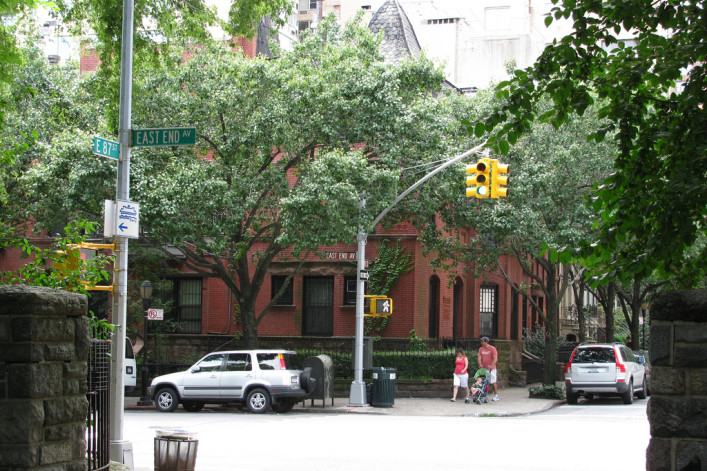Henderson Place: The charming corner of Manhattan you've never heard of

Get into a taxi and say, “Henderson Place, please” and it’s a safe enough bet that your driver won’t have any idea what you’re talking about. Nor would most New Yorkers. Henderson Place is the name given to the small (less than half an acre) group of contiguous homes built on the Upper East Side in 1882 by John C. Henderson, right across from Archibald Gracie’s once- upon-a-time country house that is now occupied by the DeBlasios year-round.
But first, a clarification and a geographical grounding: A small dead-end street (also called Henderson Place) bounds the Henderson Place historic district, which we're focusing on here, on the west side; on the east side is East End Avenue (known back in Henderson's time as Avenue B). The enclave is sandwiched between 87th Street due north and 86th Street on the south; approximately 90 feet of East 87th Street -- and part of 86th -- going north from East End is also part of it. Eight homes due west of Henderson Place (the street) were torn down by a wrecking ball in 1940, bringing the number of homes in the district down to 24 from the original 32. (NYC deplores a vacuum so the missing eight were replaced two decades later by a luxury 22-floor co-op named Henderson House.)
Wonky boundaries aside, Henderson Place is worth a weekend afternoon visit, which can be combined with a stroll through its “backyard” and one-time piece of Gracie’s property, Carl Schurz Park. It's an architectural detour into 1800s NYC, when the UES as we know it was far in the making but definitely on its way. Here, five facts you probably don't know about Henderson Place.
1. John C. Henderson was a savvy real estate developer—one of NYC’s first.
Although no one was actually called a real estate developer in the 1800s, Henderson, the man who bought the land, built the homes, and eponymously named them, was exactly that. He bought it as an investment, a way to put to good use the money he earned at his core business—importing furs and ostrich feathers and making fur hats and products made of straw.
The parcel that Henderson bought from Joseph Foulke had belonged to Gracie and John Jacob Astor (the undisputed king of 19th century “developers”). By the mid-1800s the value of Henderson’s land had been enhanced by the fact that 86th Street had been graded, making it a popular east-west thoroughfare. Moreover, the New York and Harlem Railroad Company, an early iteration of Metro-North, according to the Harlem Valley Rail Trail Association, had lain tracks all the way from the Village up to Yorkville. The area had become accessible to more than just the super rich.
2. Henderson Place was built for “persons of moderate means.”
This is probably the most surprising fact of all for anyone who lives in 21st century, luxury-condo-fied New York City: These beautiful, architecturally interesting homes, embellished with interesting decorative elements were built for ordinary working people. And there’s more: Henderson hired the architectural firm of Lamb and Rich to design the block of homes — the same architects who were working at about the same time on Sagamore Hill, Teddy Roosevelt’s elegant summer home in Oyster Bay, Long Island. As Christopher Gray wrote in a New York Times article describing Henderson Place, the architects “called on all the charming details in their portfolio and lavished them on the complex.”
The first tenants of Henderson Place were, indeed, working class. Gray reports that early directories indicates them working as electricians and the like. The 1905 census shows that some of the houses were occupied by what would seem to be large families: A florist at 11 Henderson Place lived with eight other people; most houses had five or six residents. A Times real estate ad listed a rent of $650 a year when traditional row houses were renting for $700 to $1,500. These “traditional” houses were bigger, though, usually four or five stories high on plots 100-foot deep as compared to Henderson’s houses which were usually three stories high on lots 18 feet wide and 46 feet deep. Most of the original homes had about 2,500-square-feet of living space, and five small bedrooms.
3. Henderson Place is one of the first of New York City’s landmarked historic districts.
In 1969, Henderson Place was designated an official New York City historic district just a few years after the Landmark Law went into effect. Only five others were designated before it.
According to the Landmarks Preservation Commission’s report on the district, it deserved historic district status because its 21 contiguous dwellings (som of the 24 were combined) “are remarkable for the uniform effect they produce”, their “characteristic Queen Anne style of architecture,” and their “charm and dignity considering they were built for people of modest means.”

Eden, Janine and Jim
A word about the Queen Anne style: The style was developed between 1870 and 1910 by Scottish architect, Norman Shaw, though Queen Anne ruled in the beginning of the 18th century. The name is something of an homage to the style of her her time, and combines the comfortable with the romantic and mixes it all up with various architectural features that appeal to people who want something a bit unique.
Some of the homes have been altered over the years, some combined (why is why there are only 21 now) and some have had floors added but once they were declared part of an historic district, that practice came to a quick halt. According to the Commission the truest-to-the-original stretch is on East 87th Street.
4. The paparazzi would have loved it in the 1920s.
Around the 1920s, Henderson Place began to be a favorite of a group of Bohemians—writers, actors and musicians of the time who either owned or rented homes there or partied with the people who did. The list of notables includes Alfred Lunt and Lynn Fontane, John Barrymore, Noel Coward and Joseph Willard Roosevelt, Teddy’s grandson.
It’s doubtful that Henderson could have foreseen the day when the Duke and Duchess of Richelieu would live in one of the homes he's built for folks of modest means. But, the Duke and Duchess did live there during the 1920s—in 146 East End Avenue—although while there, they went under the more unassuming name of Mr. and Mrs. Jean Chapelle.

This house on 142 East End Avenue is part of the historic Henderson Place District.
5. You can move in to Henderson Place now if you’d like (and can afford it).
Want to buy a home two doors down from where the Duke and Duchess lived? A mere $7.5 million gets you keys to 142 East End Avenue. Your new home will have 11 rooms: Five bedrooms, almost 4,000 square feet of indoor space, and 500 square feet outdoors. The house has fourth and fifth floor additions to the original which makes it one of the largest of the complex. No one lives there now and it’s been recently gutted and “painstakingly renovated” according to the Sothebys listing.
It’s no surprise that houses that are part of the Henderson Place set-up seldom enter the market. One sold at 10 Henderson Place (all houses on the actual street called Henderson Place come with their own parking spot in front) went for just under $3.5 million at the end of 2013. Rentals are rare, too, but according to Zillow’s calculations, if one were to surface, it would cost over $10,000 per month.
Related:
Five things you didn't know about Chelsea's London Terrace (but shouldn't)
Manhattan Valley: What you might not know about the Upper West Side's neighbor to the north


























